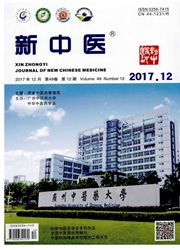

 中文摘要:
中文摘要:
目的:探讨三七总皂苷治疗帕金森病(PD)的作用靶标。方法:采用6-羟基多巴胺偏侧损毁黑质制备PD大鼠模型,区层随机分为模型组、三七总皂苷低、高剂量组,另取不造模大鼠为正常对照组,只注射抗坏血酸大鼠为假手术组。观察PD大鼠神经行为学、酪氨酸羟化酶(TH)及多巴胺转运体(DAT)m RNA、脑源性神经营养因子前体蛋白(pro-BDNF)蛋白、胶质细胞源性神经营养因子(GDNF)阳性细胞数量的变化及三七总皂苷的治疗作用。结果:三七总皂苷可改善PD大鼠旋转行为(P〈0.01);升高TH及DAT m RNA表达(P〈0.01);增加pro-BDNF蛋白的含量(P〈0.01);升高GDNF阳性细胞表达数(P〈0.01)。结论:三七总皂苷的作用靶标是神经行为学、TH及DAT mRNA、pro-BDNF蛋白、GDNF阳性细胞。
 英文摘要:
英文摘要:
Objective: To research the targets of Panax notoginseng saponins (PNS) in the treatment of Parkinson's disease (PD). Methods: PD rat model was established by damaging the side substantia nigra by using 6-hydroxydopamine. The rats were layer randomly divided into model group, PNS groups (low, high dose), normal control group, sham operation group. The changes of neural behavior and mRNA with TH and DAT and content of pro-BDNF protein number of GDNF positive cells were detected. Results: The rotational behavior in PD rats were improved by PNS (P〈0.01); the mRNA expression of TH and DAT were increased (P〈0.01), the content of pro-BDNF protein were increased (P〈0.01), and the expression of GDNF positive cells were increased (P〈0.01). Conclusion: The targets of PNS are neuroethology, TH and DAT mRNA, pro-BDNF protein, and GDNF positive cells.
 同期刊论文项目
同期刊论文项目
 同项目期刊论文
同项目期刊论文
 期刊信息
期刊信息
